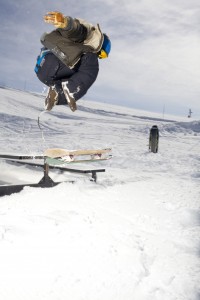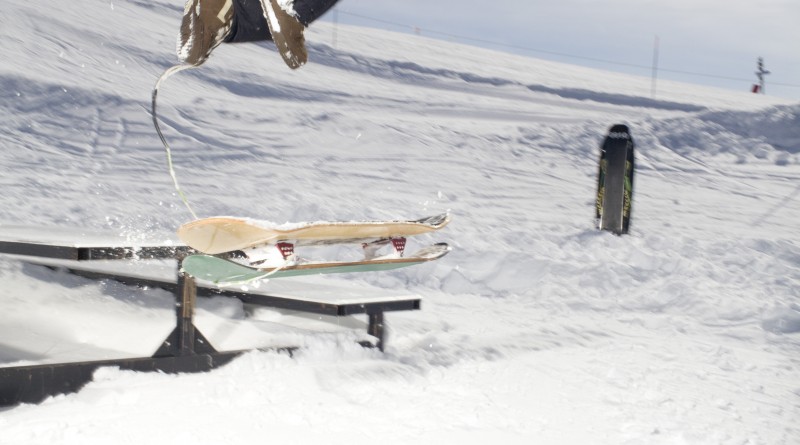On Board With Snowskating

Steven Bourdelais was a devoted skier—a racer since grade school and an instructor at Crotched Mountain in New Hampshire—until one day two guys zipped by him on small, double-decked skateboard/ski combos. “They ollied up,” he remembers, “grinding a stair set before riding to their car, then hopped in and headed off.” At the time, Bourdelais did not snowboard or skateboard—and didn’t even know exactly what he had seen—but he knew he had to have one: a bi-deck snowskate. “I bought one that night,” he says with satisfaction, “and now I teach a lesson on skis, then run in, switch to shoes, and grab my skate.”
A growing number of people are discovering the thrill of riding a bi-deck snowskate: a skateboard deck mounted via metal trucks to a ski. They have been steadily proving that snowskaters can go anywhere and do anything that skiers and snowboarders do.
Unlike the plastic “park toys” churned out by big companies in decades past, today’s skates are created by small snowskate-only companies out of top-notch materials and sophisticated, precisely engineered designs. They come in a variety of shapes and sizes and can be ridden on any terrain—riders simply hop on and carve down the mountain. A leash keeps the board from getting away, and a combination of skill, balance, and grip tape keeps the rider on the board. The size of the ski mounted under the snowskate deck varies according to the terrain to be ridden, with small skis fitting parks, tricks, and general riding, while large skis carve easily through powder. “Ideally, you can have [at least] one deck and be able to change out the subs (bottom skis) depending on the conditions. I have one deck with two subs that I interchange whether it’s powdery or slushy,” Bourdelais says.
The newest skates are a vast improvement over previous versions, says Brad Quintin, a Vermont native who has been snowboarding and skiing since the age of 3. “I first saw snowskates 10 years ago—single-deck boards,” he says. “Later, I tried the Burton double-deck snowskates. They never left much of an impression.” After trying a modern snowskate, however, he was hooked. “Two years ago, closing day at Jay Peak, I got on a real snowskate. I fell in love instantly because my first day I was able to rip up the mogul trails and everything else. The snowskate gives you more enjoyment per run, and it is way harder, it’s more badass,” Quintin says. “I take more turns on the skate. The board makes the biggest difference.”
Due to vastly improved boards and savvier riders, snowskating has finally arrived as a bona fide sport. Resorts worldwide have been vigorously welcoming snowskaters, and the sport can now claim its own magazines, blogs, and films (see sidebar). Groups and competitions have sprung up recently in Japan, Norway, France, Austria, Germany, and even Dubai, as well as in most major ski areas in the United States and Canada. Snowskating is flourishing in Vermont, as elsewhere. Bourdelais is partial to Mount Snow, while Quintin, and Jimmy Underwood, a New Hampshire native who has ridden all over the United States and beyond, are devoted to Jay Peak. “Jay Peak has always ruled,” says Underwood. “It is there that I’ve snowskated with the most people.”
A one-time fad, snowskating has ultimately demonstrated an enduring appeal. The portability, unfettered stance, and limited gear give the sport an ease and versatility that is addictively liberating. Snowskates are easy to take backcountry, as they are lighter and more easily packed than snowboards, plus they have no bindings and do not require special shoes or any special equipment beyond a leash and a board. These same attributes also make them perfect for all-mountain or park riding too: no more dangling and dragging heavy boards, strapping in and out, or clumping around all day in heavy, uncomfortable boots. “It’s freedom,” Bourdelais says. “I’ve never surfed, but I imagine it’s the closest thing to surfing on snow that there is. I love it, it’s so much fun.”



